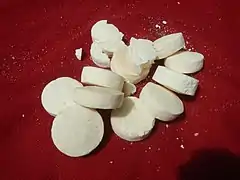Puto seco
Puto seco, also known as puto masa, are Filipino cookies made from ground glutinous rice, cornstarch, sugar, salt, butter, and eggs. They are characteristically white and shaped into thick disks. They have a dry powdery texture.[1][2]
 | |
| Alternative names | puto masa, puto seko, dry puto, coconut angel cookie |
|---|---|
| Type | Cookie |
| Place of origin | Philippines |
Etymology
The name is derived from Filipino puto (traditional Filipino steamed rice cakes) and Spanish seco ("dry"), in reference to its texture. It is also spelled as "puto seko".[3]
Description

Traditional puto seco is made from galapong, ground glutinous rice grains soaked in water overnight. However, modern versions are more commonly made with rice flour or all-purpose flour. It is mixed with cornstarch, butter, eggs, salt, and sugar. Milk can also be added. It is baked until it becomes dry and brittle. Some modern versions of puto seco come in other flavors like ube (purple yam), coconut, and buko pandan.[4][5][6][7][8]
Multicolored candy-like versions of puto seco are sometimes known as puto masa (lit. "corn dough puto"). This variant is common in the provinces of Laguna and Batangas.[9]
Similar dishes
Puto seco is very similar to other traditionally powdery cookies in the Philippines like masa podrida and uraró.[10]
See also
References
- "List of Filipino cookies, biscuits, and crackers". Glossary of Filipino Food. Retrieved 6 April 2019.
- "Puto Seko". Bucaio. Retrieved 6 April 2019.
- Polistico, Edgie (2017). Philippine Food, Cooking, & Dining Dictionary. Anvil Publishing, Incorporated. ISBN 9786214200870.
- "Puto Seko". Kawaling Pinoy Tasty Recipes. Retrieved 6 April 2019.
- "Puto Seko". About Filipino Food. Retrieved 6 April 2019.
- "Puto Seco". Kisekiya2. Retrieved 6 April 2019.
- Paguio, Renz Lyndon. "Home-based business idea: How to make puto seko". Entrepreneur Philippines. Retrieved 6 April 2019.
- "Best Puto Seco (Puto Seko) Recipe". Cook With Major. Retrieved 6 April 2019.
- "List of puto varieties". Glossary of Filipino Food. Retrieved 6 April 2019.
- "URARO". Tagalog Lang. Retrieved 26 March 2019.

